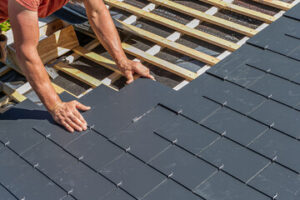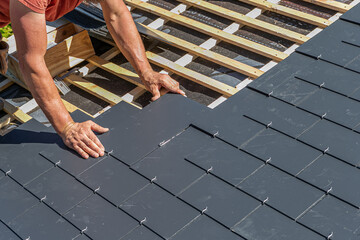A roof protects more than just the interior of your home. It’s your first line of defense against the elements and a vital part of your home’s structural integrity.
Repairing a damaged roof can help prolong its lifespan, saving you money on recurring repairs and potential interior damage. It can also prevent costly underlying damage to your home and save you on energy costs.
Your roof is your first line of defense against the elements. It shields you from rain, wind, snow, and sleet while also providing insulation, structural support, and ventilation. Whether you have a simple gable roof or a complex, steep-pitched design with multiple angles and custom features like dormers and skylights, it must be in good condition to prevent leaks and protect your family.
Damaged shingles can be caused by extreme temperatures, severe storms, improper installation, and even unsupervised “roof-walkers.” When a shingle becomes damaged, it’s important to have it replaced right away to protect the rest of your roof. Water penetration can lead to serious, costly issues like mold growth, wood rot, and structural damage.
You’ll know you have a damaged shingle if you see water stains on your ceilings or walls, damp spots in the attic, or visible dripping during a rainstorm. To repair a damaged shingle, first loosen the shingles above it with a crowbar or similar tool. Then, use your tool to pry up the nails that hold the shingle in place. Once the nail is free, pull up the shingle and replace it with a new one. Make sure to match the color of the new shingle to the existing ones.
Roof repair services also include repairing the fascia board, which runs along the bottom edges of your roof to prevent gutters from clogging and to protect against water damage and animal infestation. The fascia is usually made of a durable wood material, but aging and exposure to the elements can cause it to deteriorate or become compromised. Replacing a deteriorated fascia board is typically easier and more affordable than replacing the entire roof, especially if you’re planning to sell your home soon.
A well-maintained shingle roof is typically covered by your homeowners insurance in the event of damage, but the specifics of your coverage depend on the cause of the damage, your policy’s terms and conditions, and any applicable deductibles. Even if your policy covers the repairs, it might be wise to consider a full roof replacement to future-proof your home against the possibility of additional harsh weather or other problems.
Repairing Leaks
A leaking roof is more than just an inconvenience. It can also lead to structural damage and mold issues. If you suspect that your roof is leaking, the best course of action is to make emergency repairs as soon as possible to avoid costly water damage. Here are some of the most common signs that you have a leaky roof:
Water Stains or Ceiling Cracks
If you notice water stains on your ceiling, it’s important to act quickly. Water stains may indicate a leaky roof, but they can also be caused by other problems such as missing shingles or clogged gutters.
Other signs of a leaky roof include mold or mildew inside your home, dark streaks on rafters and roof decking, and a musty or damp smell. You can also check for signs of sagging on the ceiling or in the attic, which can be caused by water damage.
Repairing a leaky roof is easier than you might think, but it’s still important to find the source of the leak before beginning work. To do this, you’ll need a ladder and someone to stay inside while you inspect the roof. Start at the bottom of the house and work your way up, checking for areas where the shingle or tiles have been removed, soft or sagging spots, or flashing that is broken or missing.
Once you’ve found the source of the leak, you can use roofing tar to seal it up. Using a putty knife, spread the tar over the damaged area and cover it with a piece of plywood or plastic roof covering, pressing firmly to create a strong seal.
Leaks are often the result of worn-out or improperly installed flashing, which is the material that covers and protects roof features like vents, chimneys, skylights, dormer windows, and gutters. If you have a leaky roof, it’s essential to replace or reseal the flashing as soon as possible to prevent future problems.
Keeping up with regular inspections and prompt repairs will help extend the lifespan of your roof. In addition, removing debris regularly will help prevent the buildup of standing water that can cause structural damage and leaks.
Replacing Damaged Flashing
Roof flashing is an important part of the roofing system that prevents water infiltration at vulnerable points such as joints and valleys, skylights, and chimneys. However, the flashing can become damaged over time due to weather conditions, wear and tear, or improper installation. It is important to inspect the flashing regularly and take steps to address any problems before a storm hits.
Flashing repairs can be performed on a DIY basis, but it is always recommended to seek professional assistance for more complex or permanent repair solutions. A professional roofer has the knowledge, experience, and specialized tools to identify and properly repair any underlying issues that could lead to further damage.
Inspect the Flashing: Before starting any repairs, carefully inspect the flashing around problem areas such as chimneys, vents, and roof valleys. Look for rust, cracks, gaps, or any other signs of deterioration. If you are not comfortable climbing a ladder to assess the condition of the flashing, consider hiring a professional for a thorough inspection.
Repair Visible Gaps or Cracks: Roof sealant or caulk can be applied to visible cracks or gaps in the flashing to create a watertight seal and protect against leaks. Choose a high-quality product that is designed for use with roof flashing to ensure a proper seal.
Secure Loose Flashing: Using roofing screws to secure loose flashing can help minimize the risk of water infiltration during a storm. Ensure that the screw head is fully embedded in the flashing to prevent movement and prevent water from entering through the gap.
Apply an Elastomeric Roof Coating: An elastomeric coating is a convenient and easy way to temporarily cover and seal compromised flashing. Choose a product that is designed for roof flashing and follow the manufacturer’s instructions to ensure complete coverage.
Ignoring damaged roof flashing can result in significant structural issues as water seeps into the home’s interior and causes rot and mold. In addition, leaks can cause water damage to other components of the building such as drywall, flooring, and furnishings. In some cases, the water can also wreak havoc on the foundation of the structure by causing sagging or damaging support beams.
Replacing Damaged Underlayment
Underlayment is a soft, squishy material that can be ruined by water. If it becomes soaked, it’s time to replace it. The first step is to examine the area for the source of the damage, which is often due to leaks or poorly vented and insulated areas. Repairing the cause will help prevent further problems and improve energy efficiency.
Use a circular saw to cut through the old underlayment panel. Be sure to wear safety goggles, since the cutting process creates small metal fragments. Once you have a section removed, inspect it for stray nails or staples that pull through the underlayment and into the subfloor.
If you plan to sell your home in the future, consider replacing your roof with resilient materials that increase resale value and future-proof it from additional harsh weather conditions. While repairs are cheaper, a complete replacement will save you from recurring roofing bills and give you peace of mind. Whichever option you choose, be sure to hire a professional contractor. They’ll ensure your new roof is structurally sound and water-tight.


 Your roof protects your home and everything in it. Without it, you’d be exposed to rain, wind, hail, insects, and other hazards that can quickly ruin your home. Whether your roof is brand new or well past its prime, it can sustain damage during storms and other environmental events that can leave you with costly repairs. That’s why it’s important to stay on top of your roof maintenance and repairs to keep it in good condition.
Your roof protects your home and everything in it. Without it, you’d be exposed to rain, wind, hail, insects, and other hazards that can quickly ruin your home. Whether your roof is brand new or well past its prime, it can sustain damage during storms and other environmental events that can leave you with costly repairs. That’s why it’s important to stay on top of your roof maintenance and repairs to keep it in good condition.
